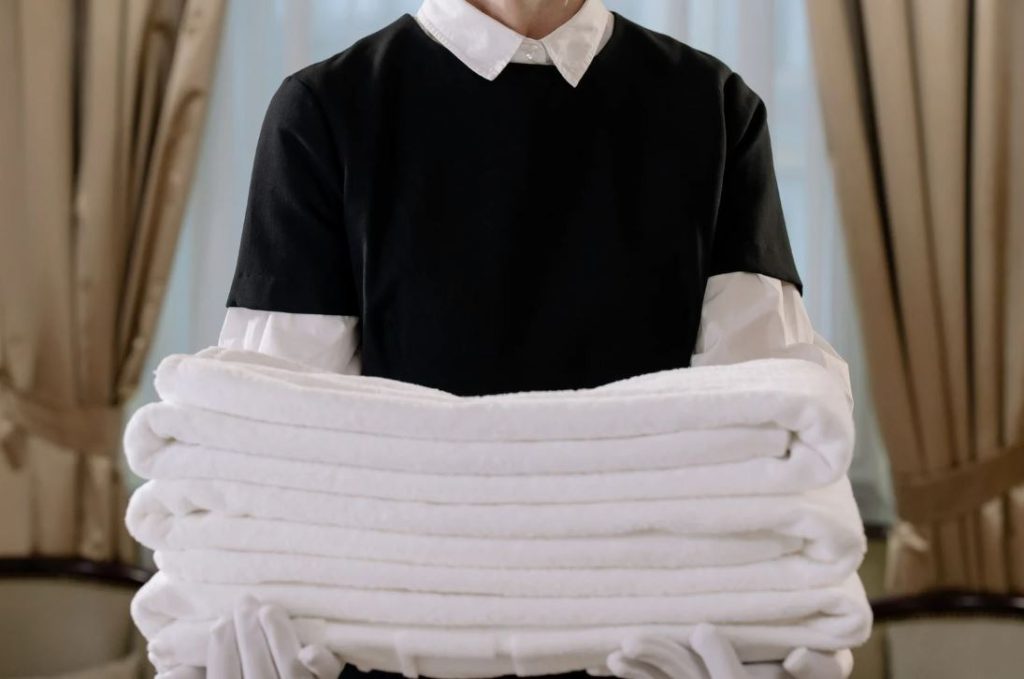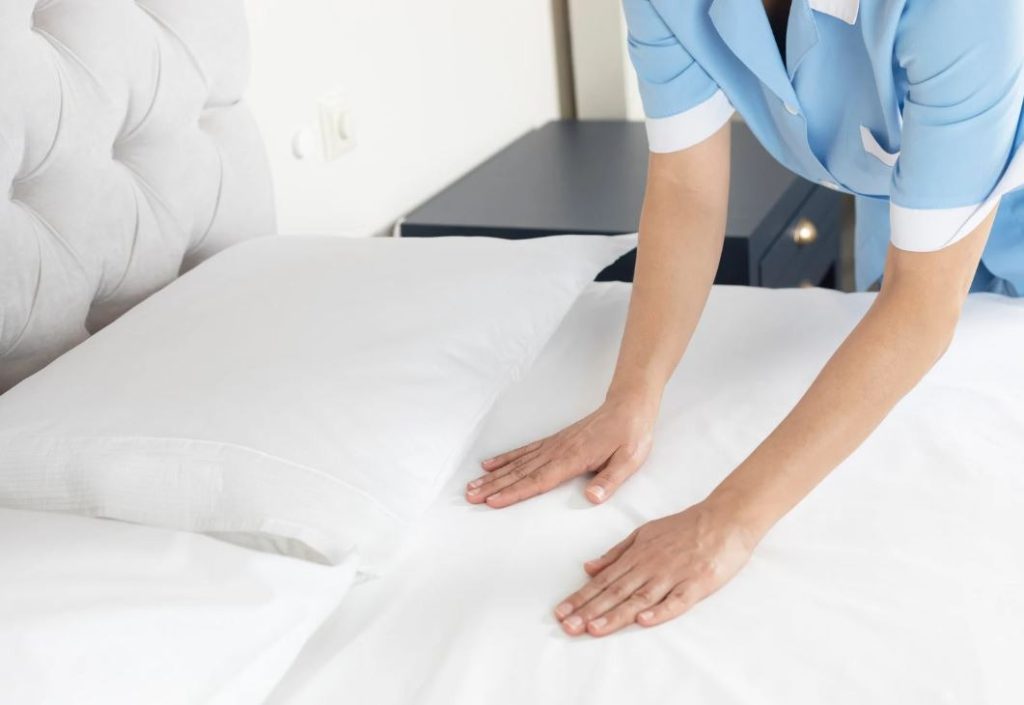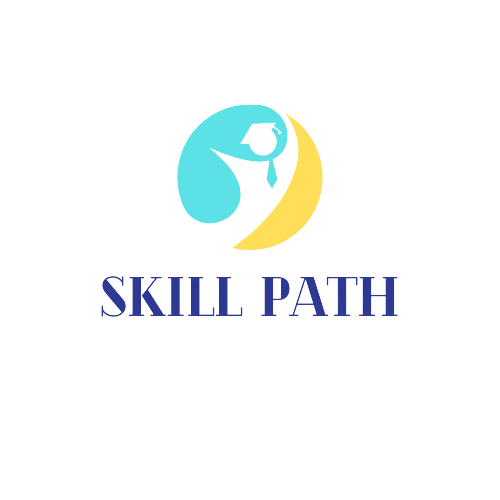
Quick Overview
The 5S rules of housekeeping, originating from Japanese management philosophy, provide a simple yet powerful framework for creating order, efficiency, and lasting cleanliness in any workplace.
This guide covers:
✅ The five core 5S principles — Sort, Set in Order, Shine, Standardise, and Sustain — and how they apply to housekeeping.
✅ Practical examples for hotels, offices, factories, and healthcare facilities.
✅ The benefits of 5S, including improved safety, efficiency, and professionalism.
✅ Smart cleaning and organisation tips inspired by the 5S system for 2025.
✅ How to sustain 5S practices long-term through training, audits, and teamwork.
A tidy, clean, and safe environment actually helps people be productive. Having an organised hotel, office, or industrial facility helps people be safe and have a positive outlook. For day-to-day operations to run seamlessly, housekeeping of the structure must be considered.
The 5S rules for housekeeping originated from Japanese management philosophy. The philosophy provided an effective method for establishing order and consistency within a workplace.
In this text, we will look at the 5S rules and how they relate to housekeeping and discuss why they remain one of the most effective techniques to lean housekeeping and improve workplace performance for the year 2025 and the years to come.
What Are the 5S Rules for Housekeeping?
The 5S methodology in housekeeping come from the Japanese language, and each one correlates to a step involved with attaining an efficient environment. The steps are:
- Seiri (Sort)
- Seiton (Set in order)
- Seiso (Shine)
- Seiketsu (Standardise)
- Shitsuke (Sustain)
The process builds a step at a time through an unbroken chain, and each of the steps revolves around discipline, productivity, and cleanliness.
Although 5S originated in manufacturing, it’s now widely used in housekeeping standards and best practices for hotels, offices, hospitals, and schools — essentially anywhere organisation and hygiene are essential.

Seiri (Sort) – Remove What’s Not Needed
The first rule of 5S housekeeping is Seiri. This step involves identifying and removing unnecessary items from the workspace – anything that does not add value or serve a purpose.
In Practice:
Discard broken tools, expired cleaning products, or outdated paperwork. Remove duplicate items or supplies that clutter storage areas. Clearly separate “essential” and “non-essential” items.
Tip for Workplaces:
Label items as Keep, Repair, Replace, or Dispose, and create the value stream.
In Hotels:
Old linen, outdated décor, and unused equipment should regularly be removed from housekeeping departments to maintain a smart and functional operation.
Why It Matters:
Clutter leads to confusion and inefficiency, and sorting is a fundamental step to eliminating waste. It levels the workspace to help prevent accidents and gives a clearer foundation for further organisation.

2. Seiton (Set In Order) – Organise for Efficiency
After the clutter has been removed, the next step in the 5S housekeeping system is Seiton, or ‘Set in Order.’ This means arranging everything in its proper place and order, and is the principle of organisation.
In Practice:
Store cleaning supplies in order of frequency of use. Marking the shelves, cupboards, and drawers and keeping equipment close to the area where it is used most often are smart moves. Use shadow boards or pegboards for tools to make storage visual.
In Hotels:
Consistent organisation should be consulted for staff uniformity on housekeeping trolleys and for efficient time management.
In Offices:
A workspace should be efficient and effective. Therefore, files and stationery should be organised as well as logically and orderly.
In Industrial Settings:
Planning for tool and machine zones saves time. Downtimes are lessened, and workflow is maintained. Each zone should have a sign for easy identification.
Why it Matters:
The assigned organisation provides efficiency in time management. Employees have less time searching for tools, leading to quicker productivity.

3. Seiso (Shine) — Clean and Inspect Regularly
Shine also refers to maintenance and inspection. Efficient tools and safe workplaces also have visual appeal.
In Practice:
- A practice for an organisation is to have cleaning schedules.
- Encourage staff to clean as well as inspect tools and equipment.
- Signs of wear, leakage, and damage should be identified early.
- Clean floors, windows, and surfaces are essential to avoid hazards.
Professional Housekeeping Systems:
Deep cleaning in hotels and hospitals should follow a checklist from sanitising bathrooms and kitchens to polishing floors and ensuring proper ventilation. In Industrial Environments:
Cleaning regularly reduces the chance of accidents, machine breakdowns, and contamination risks. In factories and warehouses, “clean as you go” policies work wonders.
Why It Matters:
Safety, morale and efficiency are boosted in a clean environment. It also allows the identification of maintenance problems that help in avoiding costly problem escalations.

4. Seiketsu (Standardise) — Create Consistent Practices
The fourth rule of 5S is Seiketsu, or standardisation. After implementation of the first three, they must be sustained through clear guidelines and procedures.
In Practice:
- Housekeeping protocols or visual charts should be created.
- Cleaning checklists should be formed for daily, weekly, and monthly tasks.
- Responsibilities should be assigned to specific individuals or teams.
- Cleaning zones or equipment should be colour-coded.
For Hotels:
Uniform procedures must be established for cleaning guest rooms, lobbies, and laundry areas to ensure quality consistency across shifts and departments.
For Offices and Workplaces:
The arrangement of desks and supply areas, as well as break rooms, should be standardised to achieve a professional and efficient environment.
Lean Housekeeping Techniques:
Using visual aids like wall charts, photos, and audit checklists guarantees that every team member is clear on expectations and that everyone is following the same process.
Why It Matters:
Standardisation increases consistency, quality control, and accountability, which reduces confusion and improves performance.

5. Shitsuke (Sustain) — Maintain and Improve
The last guideline Shitsuke translates to “discipline” or “sustain”. It ensures the other four principles comfortably fit into the routine and do not become temporary actions.
In Practice:
- Perform periodic inspections or 5S audits.
- Getting staff to participate in periodic refresher training.
- Encouraging self-discipline and pride in maintaining cleanliness.
- Recognition of sustained performance and improvement of efforts.
In Hospitality:
Supervisory staff in the hospitality sector are to celebrate and acknowledge standards of service in staff, as well as provide constructive praise.
In Workplaces:
Managers are to exemplify the standards of service they expect to see from employees — organise and clean to the standards.
Why It Matters:
Professional systems of housekeeping are characterised by maintaining order, improvement, and not backsliding. That means the systems are sustainable.

Benefits of Implementing 5S in Housekeeping
5S in housekeeping provides measurable results in various sectors: hospitality, offices, factories, and even health care.
1. Improved Efficiency
Searching for items decreases, leaving more time for the task at hand.
2. Enhanced Safety
Accidents caused by clutter and misplaced tools become a rarity.
3. Higher Quality Standards
Service improves, and customers are happier with the results due to the consistency in cleaning and order.
4. Employee Morale and Ownership
A workplace cleaning and organization increases everyone’s pride and motivation. It encourages teamwork because everyone feels responsible for maintaining the standards.
5. Cost Savings
Long-term savings are the result of preventative maintenance and reduced waste, as well as saving costs on supplies, repairs, and labour.
6. Compliance and Professionalism
Health and safety regulations are followed, while standardised systems promote professionalism. The same systems promote professionalism and a positive image.

How 5S Applies Across Industries
5S is a universal concept used in many industries.
Hotels and Hospitality
5S principles for hotels and offices streamline efficiency in the housekeeping workflow, leading to quicker and more consistent room cleanings. As staff follow identical routines, errors are reduced, resulting in higher guest satisfaction.
Offices and Corporate Buildings
In office settings, 5S encourages staff to keep their desks clean, filing systems organised, and space to be used in a more efficient way. This boosts productivity and lowers workplace stress.
Factories and Industrial Sites
In industrial settings, 5S principles directly support industrial cleaning and safety rules. Designated work zones, tool shadow boards, and daily cleaning prevent accidents and equipment failure.
Healthcare and Laboratories
Infection control, equipment tracking, and overall compliance with cleanliness regulations in the medical setting are supported through the same framework.
Smart Cleaning and Organization Tips (Inspired by 5S)
Incorporating the 5S strategies into housekeeping practices, in the same way as managing work, is also possible.
- Utilise Apps- Mobile applications serve as cleaning checklists and as reminders to perform cleaning tasks.
- Colour-Coded Cleaning- Use different colored cleaning cloths and bins to minimise cross-contamination.
- Visual Aids- Use simple images or labels to assist in remembering where to put things and maintaining order.
- One-Minute Rules- If the action takes less than a minute to complete, do it right away, for returning tools or wiping down a surface.
- Sustainable and Efficient- Using biodegradable cleaning products and refillable containers for cleaning tools helps in sustaining the environment while staying efficient and clean.
- Everyone participates- Building a culture where everyone is responsible for the cleanliness and order of the workplace is essential.
These small but consistent actions reinforce the 5S workplace efficiency guide in daily life.
Maintaining 5S Housekeeping Moving Forward
The key to 5S is to hold on to it, and it is the most challenging part. There are many workplaces that put up 5S and see great positive results, only to see a lack of commitment to their standard.
Sustainability Tips:
- Use the visible scoring tools to perform 5S audits monthly.
- Offer a small prize for a work area that is consistently neat.
- Conduct regular training as well as pass it on to new staff.
- Include 5S in the performance appraisal process as well as in safety meetings.
When everyone participates and takes responsibility, 5S flows naturally into daily work rather than as an additional task.

Final Thoughts
What are the 5S rules for housekeeping?
They are the following:
- Sort (Seiri) – Get rid of what isn’t needed.
- Set in Order (Seiton) – Organize for efficiency.
- Shine (Seiso) – Clean and examine often.
- Standardise (Seiketsu) – Form uniform processes.
- Sustain (Shitsuke) – Keep discipline and ongoing improvement.
In this way, all five steps take disorganised and inefficient spaces and turn them into clean, safe, and productive surroundings.
Of all the standards and best practices for 5S housekeeping, implementing just these in a hotel, office, factory, or healthcare facility will impact the workplace and professionalism the most. The benefits will range from happy employees to improved efficient housekeeping workflow.
Smart work, not just hard work, leads to brilliant housekeeping. The 5S method is one of the most brilliant and effective approaches to maintain order, cleanliness, and efficiency in any workplace. just hard work, leads to brilliant housekeeping. The 5S method is one of the most brilliant and effective approaches to maintain order, cleanliness, and efficiency in any workplace.
